Enhanced oncolytic adenoviral production by downregulation of death-domain associated protein and overexpression of precursor terminal protein
- PMID: 33441685
- PMCID: PMC7807022
- DOI: 10.1038/s41598-020-79998-1
Enhanced oncolytic adenoviral production by downregulation of death-domain associated protein and overexpression of precursor terminal protein
Abstract
Adequate viral replication in tumor cells is the key to improving the anti-cancer effects of oncolytic adenovirus therapy. In this study, we introduced short hairpin RNAs against death-domain associated protein (Daxx), a repressor of adenoviral replication, and precursor terminal protein (pTP), an initiator of adenoviral genome replication, into adenoviral constructs to determine their contributions to viral replication. Both Daxx downregulation and pTP overexpression increased viral production in variety of human cancer cell lines, and the enhanced production of virus progeny resulted in more cell lysis in vitro, and tumor regression in vivo. We confirmed that increased virus production by Daxx silencing, or pTP overexpression, occurred using different mechanisms by analyzing levels of adenoviral protein expression and virus production. Specifically, Daxx downregulation promoted both virus replication and oncolysis in a consecutive manner by optimizing IVa2-based packaging efficiency, while pTP overexpression by increasing both infectious and total virus particles but their contribution to increased viral production may have been damaged to some extent by their another contribution to apoptosis and autophagy. Therefore, introducing both Daxx shRNA and pTP in virotherapy may be a suitable strategy to increase apoptotic tumor-cell death and to overcome poor viral replication, leading to meaningful reductions in tumor growth in vivo.
Conflict of interest statement
The authors declare no competing interests.
Figures
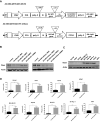

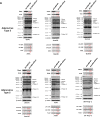

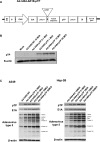








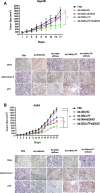
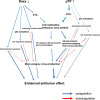
Similar articles
-
Silencing Daxx increases the anti-tumor activity of a TRAIL/shRNA Bcl-xL-expressing oncolytic adenovirus through enhanced viral replication and cellular arrest.Cell Signal. 2015 Jun;27(6):1214-24. doi: 10.1016/j.cellsig.2015.02.028. Epub 2015 Mar 5. Cell Signal. 2015. PMID: 25748050
-
High levels of Daxx due to low cellular levels of HSP25 in murine cancer cells result in inefficient adenovirus replication.Exp Mol Med. 2019 Oct 15;51(10):1-20. doi: 10.1038/s12276-019-0321-4. Exp Mol Med. 2019. PMID: 31615977 Free PMC article.
-
E1A, E1B double-restricted adenovirus with RGD-fiber modification exhibits enhanced oncolysis for CAR-deficient biliary cancers.Clin Cancer Res. 2007 May 15;13(10):3043-50. doi: 10.1158/1078-0432.CCR-06-2103. Clin Cancer Res. 2007. PMID: 17505007
-
A compendium of adenovirus genetic modifications for enhanced replication, oncolysis, and tumor immunosurveillance in cancer therapy.Gene. 2018 Dec 30;679:11-18. doi: 10.1016/j.gene.2018.08.069. Epub 2018 Aug 29. Gene. 2018. PMID: 30171937 Review.
-
Non-Human Primate-Derived Adenoviruses for Future Use as Oncolytic Agents?Int J Mol Sci. 2020 Jul 8;21(14):4821. doi: 10.3390/ijms21144821. Int J Mol Sci. 2020. PMID: 32650405 Free PMC article. Review.
Cited by
-
The investigation of oncolytic viruses in the field of cancer therapy.Front Oncol. 2024 Jul 10;14:1423143. doi: 10.3389/fonc.2024.1423143. eCollection 2024. Front Oncol. 2024. PMID: 39055561 Free PMC article. Review.
-
Combination of Oncolytic Virotherapy with Different Antitumor Approaches against Glioblastoma.Int J Mol Sci. 2024 Feb 7;25(4):2042. doi: 10.3390/ijms25042042. Int J Mol Sci. 2024. PMID: 38396720 Free PMC article. Review.
-
Enhanced tumor targeting and timely viral release of mesenchymal stem cells/oncolytic virus complex due to GRP78 and inducible E1B55K expressions greatly increase the antitumor effect of systemic treatment.Mol Ther Oncolytics. 2022 Sep 17;27:26-47. doi: 10.1016/j.omto.2022.09.004. eCollection 2022 Dec 15. Mol Ther Oncolytics. 2022. PMID: 36247810 Free PMC article.
-
Engineered Sleeping Beauty Transposon as Efficient System to Optimize Chimp Adenoviral Production.Int J Mol Sci. 2022 Jul 7;23(14):7538. doi: 10.3390/ijms23147538. Int J Mol Sci. 2022. PMID: 35886882 Free PMC article.
References
Publication types
MeSH terms
Substances
LinkOut - more resources
Full Text Sources
Other Literature Sources

